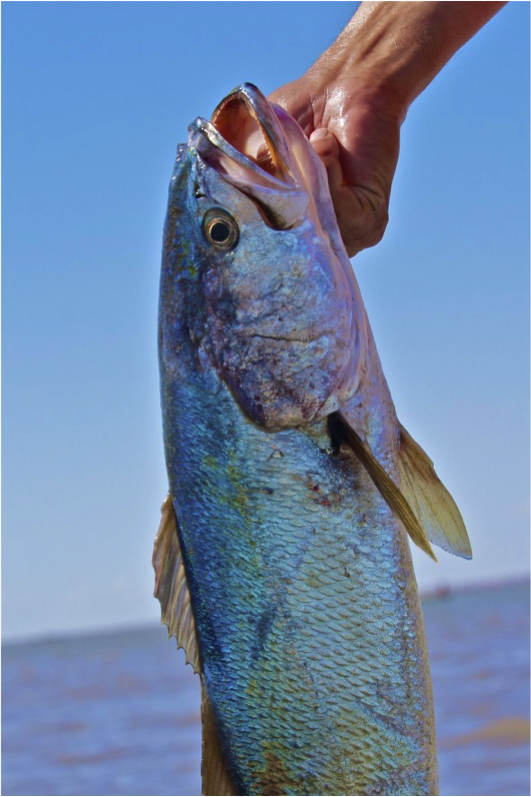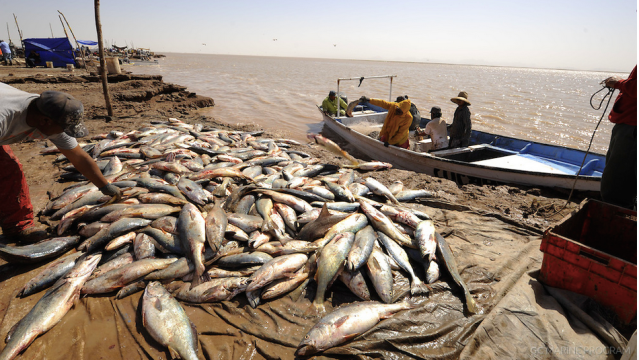Each year, over a million Gulf corvina swim to their spawning grounds along the Colorado River Delta. These fish are famous for their loud, chattering sounds, and when corvina gather together in massive conglomerations, the noise they produce is deafening. Literally. New research shows that the sounds produced by these fish when spawning are the loudest ever recorded for a single fish — an extraordinary display of nature that’s now being turned against the species.
It’s official: Gulf corvina are the loudest fish on the planet, according to new research published today in Biology Letters. Individually, these six-to-eight pound fish are noisy, but when packed together along a 26km strip (27 km) of the Colorado River Delta, their collective roar is nothing short of astounding — shaking the hulls of passing ships and threatening the hearing of any aquatic animal who dares to swim close.

A Gulf corvina. (Image: Gulf of California Marine Program Brad Erisman)
Gulf corvina are a type of “croaker” fish that can only be found in the Northern Gulf of California. Each spring, adults swim to their annual spawning areas, forming a single aggregation of several million fish. Their mating behaviour can be tied to tidal and lunar cycles, making them particularly vulnerable to fishermen, who can time the fish’s arrival to the minute. What’s more, the audible cacophony produced by the male corvina leads the fishers to their exact location. During the spawning season, a single net can catch up to two tons of corvina within a matter of minutes, and an entire fishing fleet can harvest up to 5,900 tons, or 2 million corvina, in just 20 days. Needless to say, this is hugely disruptive to the species, and scientists are now worried about the corvina’s future.
To learn more about these remarkable fish and the sounds they make, Brad Erisman from the University of Texas and Timothy Rowell from the University of California-San Diego set up camp along the Colorado River in 2014, conducting acoustic surveys of the fish during peak periods in March and April. Various instruments were used to measure fish loudness, location, and density.
The researchers estimated the noise produced by a single corvina from a standard distance of about a meter away using three different measurements of individual sound levels. The highest measurement was 190 decibels (dB) using a peak-to-peak measurement, and the peak RMS (root mean square) was 177 decibels. Below is an audio clip of many males chorusing in the background, but in the foreground an individual male can be heard swimming by. His chattering sound gets progressively louder as he passes by the microphone.
As for the collective volume of the aggregation, that was recorded at 163 dB at its peak.
“Individuals are louder than this, but sound is absorbed by the water after being released by the individual,” Rowell explained to Gizmodo. “For this reason, the chorusing is quieter than an individual.”
These decibel rates seem incredibly high (and they are), but it’s important to remember that measurements of decibels in air and water are different.
“Decibels in water are referenced to 1 uPa [sound pressure], while dB in air are typically referenced to 20 uPa,” said Rowell. “To make comparisons of sound intensity between medium, you need to subtract/add approximately 62 dB. For example, 200 dB in water is about 138 dB in air.”
As Rowell explained, the sound levels are so high because water is more efficient at transporting sound pressure than in air. So in addition to being loud, these fish transmit sounds faster and further than they would in air. That said, sound isn’t experienced differently underwater.
So a single Gulf corvina, at 177 dB referenced to 1 uPA, is louder than two 175-horse-power outboard boat engines running at 55 km/hr. “So corvina are very loud,” said Rowell. “Again, for in air comparisons subtract 63 dB from 177 dB.” That’s about 114 dB, which is about as loud as a live rock concert, and just 6 dB below the human threshold for pain.
For aquatic animals in the vicinity, this obviously poses a problem. Exposure to sounds this loud can cause permanent hearing loss in dolphins and seals. But much to the surprise of the researchers, adult California sea lions and dolphins were seen feeding in the spawning areas despite the intense racket.
As to why the fish engage in this behaviour, the researchers say its an evolutionary adaptation that allows for communication between individuals in an inherently noisy environment. It’s basically like the Lombard effect, where people unconsciously raise their voices to be heard when others around them are also speaking, but for fish. There’s also some cocktail party effect involved, which allows an individual fish to hear another fish over the din.
As noted, the sounds made by Gulf corvina are working against them, as fishers exploit this annual vulnerability. In an email to Gizmodo, Erisman said three things need to happen to improve the sustainability of the fishery:
[We need to] (1) raise the market price of the corvina so the fishermen are not forced to catch so many to make a profit. This is the biggest driver of overfishing that is not the fishermen’s fault. (2) We need to improve the way we monitor the fishery, and running these acoustic surveys is the best way to estimate the population. (3) As fishermen have been suggesting for many years, if we can simply close the fishery during the peak spawning day during each migration period (it happens every other week for 3 months), we can protect a large proportion of the spawning activity to ensure survival of enough fish to support the fishery in the future. Fishermen can still fish the other days in order to maintain their production and profit while also ensuring that spawning is successful.
This will have to be addressed sooner rather than later. The aggregations are now heavily overfished, and the researchers are already seeing signs of a decline in the corvina population through the smaller size of fish being captured, and a reduction of the area in which the aggregation is normally distributed.
“Fish are shrinking and the aggregation is shrinking,” Erisman said. “If this aggregation disappears, it means the species disappears.”
